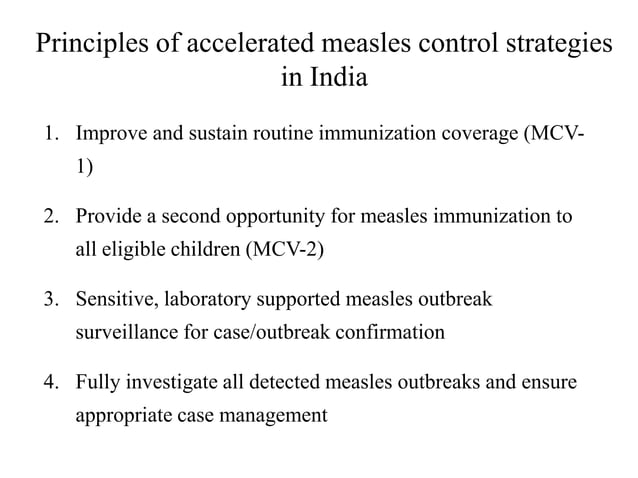Canada Faces Measles Elimination Loss: A Potential Public Health Crisis

Table of Contents
Declining Vaccination Rates: The Root of the Problem
The primary driver behind the resurgence of measles in Canada is a concerning decline in vaccination rates. This isn't just a minor fluctuation; it represents a significant threat to the collective immunity that has protected our nation for years. Achieving and maintaining measles elimination requires high vaccination coverage, and anything less leaves communities vulnerable.
Understanding Vaccine Hesitancy in Canada
Several factors contribute to vaccine hesitancy, a complex issue fuelled by misinformation and mistrust.
- Impact of online misinformation campaigns: The spread of false information about vaccine safety and efficacy through social media and online forums has significantly influenced public perception. These campaigns often exploit emotional appeals and present fabricated evidence, leading to confusion and fear.
- Role of celebrity endorsements of anti-vaccine sentiment: The endorsement of anti-vaccine views by high-profile individuals, even those without medical expertise, adds weight to the misinformation, impacting public trust.
- Influence of anti-vaccine groups and organizations: Well-organized anti-vaccine groups actively spread misinformation and lobby against mandatory vaccination policies, further undermining public health efforts.
- Lack of trust in government health agencies: Declining trust in governmental institutions, including public health agencies, contributes to vaccine hesitancy. This distrust can stem from past controversies or a perceived lack of transparency.
Vulnerable Populations and Vaccination Gaps
The impact of declining vaccination rates is not evenly distributed. Certain groups face disproportionately higher risks.
- Lower vaccination rates in specific demographics: Data shows lower vaccination rates amongst specific demographic groups, including some religious communities and those in lower socioeconomic brackets. These disparities require targeted interventions.
- Barriers to accessing vaccines in remote communities: Geographic isolation and limited access to healthcare services in remote and Indigenous communities create significant barriers to timely vaccination.
- Language barriers and cultural sensitivities impacting vaccine uptake: Language barriers and cultural sensitivities can hinder effective communication about vaccine benefits and safety, leading to lower vaccination rates among immigrant and refugee populations.
The Impact of Measles Outbreaks on Public Health
Measles is a highly contagious and potentially severe disease. Its resurgence poses a significant threat to public health, impacting individuals and the healthcare system as a whole.
Measles: A Highly Contagious Disease
Measles is easily transmitted through respiratory droplets, making it highly contagious. Even before symptoms appear, an infected individual can spread the virus.
- Symptoms of measles: Classic symptoms include fever, cough, runny nose, and a characteristic rash.
- Risk of pneumonia and encephalitis: Serious complications such as pneumonia and encephalitis can occur, leading to hospitalization and even death.
- Mortality rates, especially in vulnerable groups: Measles mortality rates are higher among unvaccinated infants, young children, pregnant women, and immunocompromised individuals.
- Long-term health consequences: Even after recovery, some individuals experience long-term complications such as hearing loss or developmental delays.
Economic Burden of Measles Outbreaks
Measles outbreaks impose a significant economic burden on individuals, communities, and the healthcare system.
- Hospitalization costs: Treating measles cases requires hospitalization, resulting in substantial costs for individuals and the healthcare system.
- Strain on healthcare resources: Outbreaks overwhelm healthcare resources, diverting attention and resources from other essential services.
- Economic impact on families and communities: Lost productivity due to illness and quarantines impacts families and communities financially.
- Costs of public health campaigns: Responding to outbreaks necessitates expensive public health interventions, including vaccination campaigns, contact tracing, and disease surveillance.
Strategies to Prevent a Measles Epidemic
Preventing a widespread measles epidemic requires a multi-pronged approach focusing on strengthening vaccination campaigns and improving surveillance systems.
Strengthening Vaccination Campaigns
Effective strategies are needed to boost vaccination rates and address vaccine hesitancy.
- Community-based vaccination initiatives: Implementing targeted vaccination campaigns in communities with low vaccination rates, addressing specific cultural and logistical barriers.
- Improved access to vaccines for marginalized groups: Ensuring equitable access to vaccines for all populations, including those in remote areas and those with limited resources.
- Public health campaigns using credible sources: Launching public health campaigns using trusted sources to counter misinformation and provide accurate information about vaccine safety and efficacy.
- Addressing misinformation through fact-checking and education: Proactively addressing misinformation through fact-checking initiatives and educational programs that empower individuals to make informed decisions.
Improving Surveillance and Response Systems
Robust surveillance and response systems are vital for detecting and containing outbreaks quickly.
- Strengthening disease reporting systems: Improving the accuracy and timeliness of disease reporting systems to enable swift identification of outbreaks.
- Improving rapid response teams: Ensuring well-trained and well-equipped public health teams are ready to respond rapidly to any reported cases.
- Investing in public health infrastructure: Investing in the necessary infrastructure, including laboratory capacity and data systems, for effective surveillance and outbreak management.
- International collaboration to monitor cross-border transmission: Collaborating with international partners to monitor and prevent the cross-border transmission of measles.
Conclusion
The decline in measles vaccination rates in Canada presents a significant threat to public health, potentially reversing years of progress toward measles elimination. Addressing vaccine hesitancy, improving access to vaccines, and strengthening surveillance systems are crucial to prevent a widespread measles epidemic. The consequences of inaction are severe, impacting individual health, healthcare resources, and the economy. We must act decisively and collaboratively to protect our communities.
Call to Action: Protect yourself and your community. Ensure you and your children are up-to-date on your measles, mumps, and rubella (MMR) vaccinations. Advocate for increased public health funding and support initiatives aimed at improving measles vaccination rates across Canada. Let's work together to prevent a devastating measles resurgence and maintain Canada's commitment to disease prevention. #MeaslesElimination #PublicHealth #Canada #Vaccination

Featured Posts
-
 Ticketmaster Vista Previa De Asientos Con Su Nuevo Venue Virtual
May 30, 2025
Ticketmaster Vista Previa De Asientos Con Su Nuevo Venue Virtual
May 30, 2025 -
 New Bts Album On The Way Summer Recording Session Details
May 30, 2025
New Bts Album On The Way Summer Recording Session Details
May 30, 2025 -
 Amysha Ptyl Ky Tsawyr Hamlgy Ky Tsdyq Ya Srf Afwahyn
May 30, 2025
Amysha Ptyl Ky Tsawyr Hamlgy Ky Tsdyq Ya Srf Afwahyn
May 30, 2025 -
 Sporting Cp Boss Amorim Thwarts Manchester United Transfer Bid
May 30, 2025
Sporting Cp Boss Amorim Thwarts Manchester United Transfer Bid
May 30, 2025 -
 Des Moines Public Schools Central Campus Agriscience Program On Hold
May 30, 2025
Des Moines Public Schools Central Campus Agriscience Program On Hold
May 30, 2025
